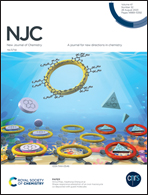Solvothermal synthesis of (Na0.8K0.2)0.5Bi0.5TiO3 piezoelectric catalyst with morphotropic-phase-boundary structure for efficient dye degradation†
Abstract
Piezocatalysis is a novel catalytic technology that has garnered significant attention from researchers in recent decades due to its ability to induce catalysis under mechanical force. In this work, a one-step solvothermal method was employed to synthesize high-crystallinity lead-free piezoelectric (Na1−xKx)0.5Bi0.5TiO3 (x = 0, 0.1, 0.2, and 0.3) materials. Their composition, structure, and piezoelectric degradation performance were analyzed in detail. X-ray diffraction (XRD) analysis revealed that the (Na0.8K0.2)0.5Bi0.5TiO3 piezoelectric material was a binary solid solution consisting of a mixture of rhombohedral (R3m) and tetragonal (P4mm) phases. Under ultrasonic vibration, the catalyst exhibited excellent degradation performance towards methylene blue (MB) solution. The reaction rate constant of (Na0.8K0.2)0.5Bi0.5TiO3 towards the MB dye was 3.51 times that of Na0.5Bi0.5TiO3 (BNT), and the degradation rate of a 10 mg L−1 MB dye solution reached 93.9% within 160 min. Free radical capture experiments demonstrated that the hole (h+) and hydroxyl radical (•OH) were the primary active species. This study provides insights into the optimization of lead-free piezocatalytic materials based on BNT.



 Please wait while we load your content...
Please wait while we load your content...